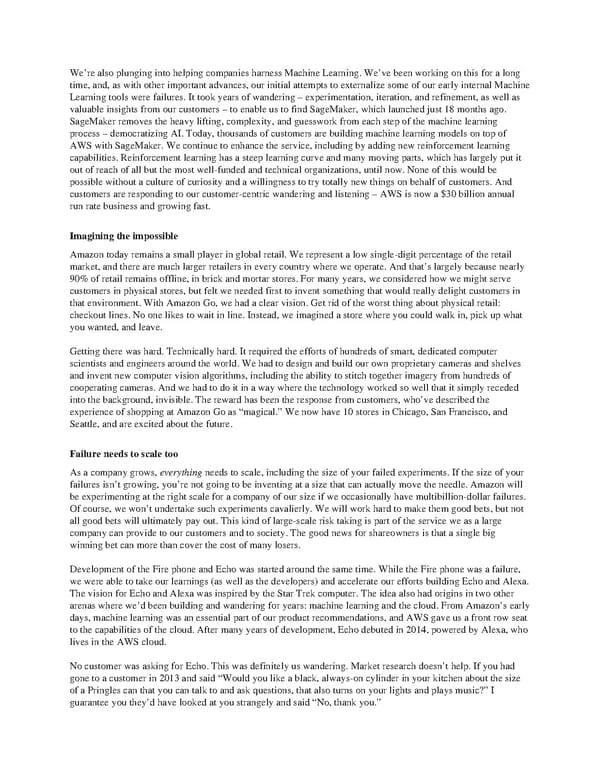We’re also plunging into helping companies harness Machine Learning. We’ve been working on this for a long time, and, as with other important advances, our initial attempts to externalize some of our early internal Machine Learning tools were failures. It took years of wandering – experimentation, iteration, and refinement, as well as valuable insights from our customers – to enable us to find SageMaker, which launched just 18 months ago. SageMaker removes the heavy lifting, complexity, and guesswork from each step of the machine learning process – democratizing AI. Today, thousands of customers are building machine learning models on top of AWSwithSageMaker.Wecontinuetoenhancetheservice, including by adding new reinforcement learning capabilities. Reinforcement learning has a steep learning curve and many moving parts, which has largely put it out of reach of all but the most well-funded and technical organizations, until now. None of this would be possible without a culture of curiosity and a willingness to try totally new things on behalf of customers. And customers are responding to our customer-centric wandering and listening – AWS is now a $30 billion annual run rate business and growing fast. Imagining the impossible Amazontodayremains a small player in global retail. We represent a low single-digit percentage of the retail market, and there are much larger retailers in every country where we operate. And that’s largely because nearly 90%ofretail remains offline, in brick and mortar stores. For many years, we considered how we might serve customers in physical stores, but felt we needed first to invent something that would really delight customers in that environment. With Amazon Go, we had a clear vision. Get rid of the worst thing about physical retail: checkout lines. No one likes to wait in line. Instead, we imagined a store where you could walk in, pick up what you wanted, and leave. Getting there was hard. Technically hard. It required the efforts of hundreds of smart, dedicated computer scientists and engineers around the world. We had to design and build our own proprietary cameras and shelves and invent new computer vision algorithms, including the ability to stitch together imagery from hundreds of cooperating cameras. And we had to do it in a way where the technology worked so well that it simply receded into the background, invisible. The reward has been the response from customers, who’ve described the experience of shopping at Amazon Go as “magical.” We now have 10 stores in Chicago, San Francisco, and Seattle, and are excited about the future. Failure needs to scale too Asacompanygrows,everything needs to scale, including the size of your failed experiments. If the size of your failures isn’t growing, you’re not going to be inventing at a size that can actually move the needle. Amazon will be experimenting at the right scale for a company of our size if we occasionally have multibillion-dollar failures. Ofcourse, we won’t undertake such experiments cavalierly. We will work hard to make them good bets, but not all good bets will ultimately pay out. This kind of large-scale risk taking is part of the service we as a large companycanprovide to our customers and to society. The good news for shareowners is that a single big winning bet can more than cover the cost of many losers. Development of the Fire phone and Echo was started around the same time. While the Fire phone was a failure, wewereabletotakeourlearnings (as well as the developers) and accelerate our efforts building Echo and Alexa. Thevision for Echo and Alexa was inspired by the Star Trek computer. The idea also had origins in two other arenas where we’d been building and wandering for years: machine learning and the cloud. From Amazon’s early days, machine learning was an essential part of our product recommendations, and AWS gave us a front row seat to the capabilities of the cloud. After many years of development, Echo debuted in 2014, powered by Alexa, who lives in the AWS cloud. Nocustomer was asking for Echo. This was definitely us wandering. Market research doesn’t help. If you had gone to a customer in 2013 and said “Would you like a black, always-on cylinder in your kitchen about the size of a Pringles can that you can talk to and ask questions, that also turns on your lights and plays music?” I guarantee you they’d have looked at you strangely and said “No, thank you.”
 Amazon Shareholder Letters 1997-2020 Page 96 Page 98
Amazon Shareholder Letters 1997-2020 Page 96 Page 98